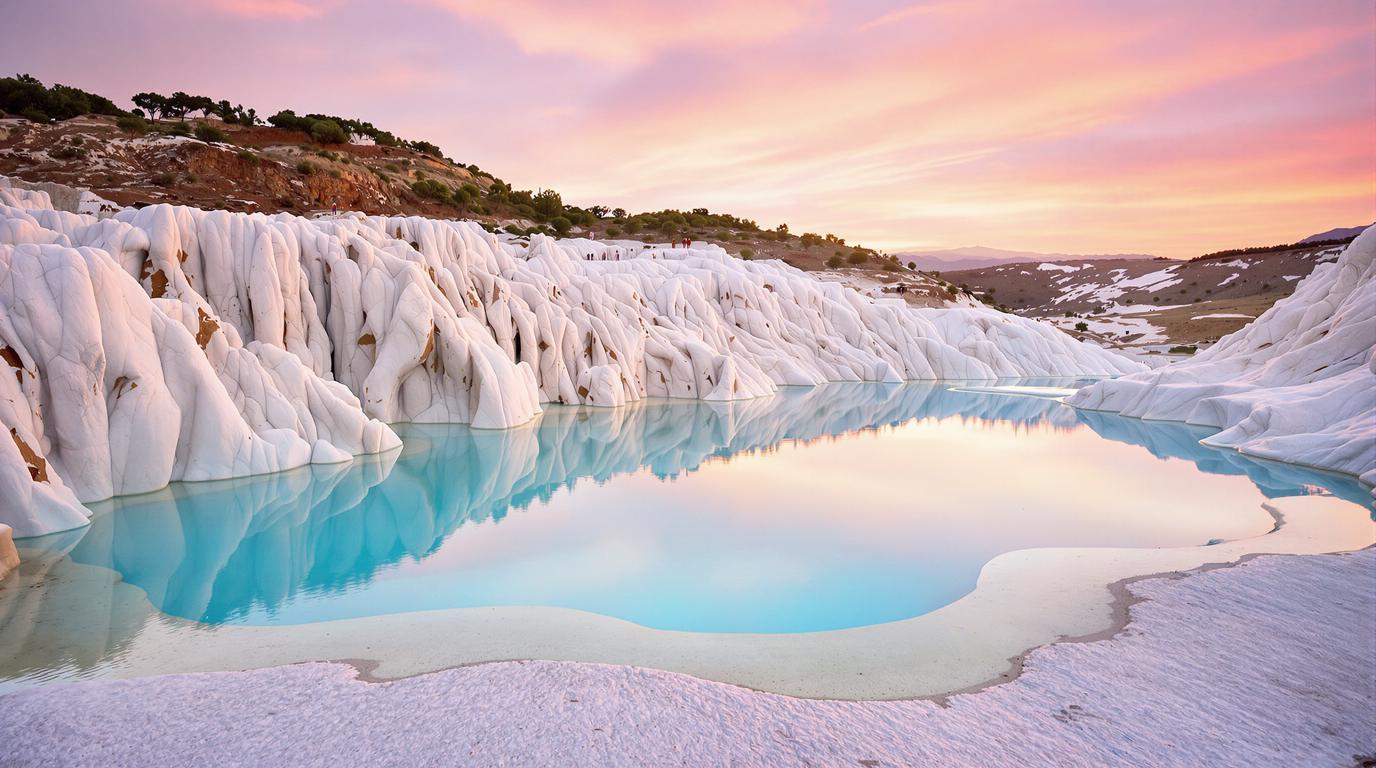The first glimpse of Pamukkale strikes many travelers as otherworldly—a cascade of gleaming white terraces that appear to be frozen in mid-flow. This geological wonder in Turkey’s Denizli Province isn’t made of ice or salt as many first assume, but rather calcium carbonate deposits formed over millennia by mineral-rich thermal waters.
Nature’s impossible architecture
The name “Pamukkale” translates to “Cotton Castle” in Turkish, perfectly capturing the surreal landscape of white travertine terraces cascading down the mountainside. These natural formations began taking shape millions of years ago as calcium-rich hot springs (reaching temperatures between 35°C and 100°C) flowed downhill, leaving behind mineral deposits that hardened into the dazzling white terraces we see today.
A UNESCO treasure with dual heritage
Since 1988, Pamukkale has enjoyed UNESCO World Heritage status alongside the ancient city of Hierapolis that sits atop the terraces. This rare combination of natural wonder and historical treasure creates one of Turkey’s most visited attractions. Walking barefoot across these gleaming terraces—a requirement to protect the delicate formations—connects you to both natural history and human civilization in a single experience.
Swim among ancient columns
Perhaps nowhere else on Earth can you swim among submerged Roman columns in warm, mineral-rich waters. Cleopatra’s Pool (also called the Antique Pool) offers visitors the unique opportunity to bathe in thermal waters while surrounded by ancient marble columns that toppled during an earthquake centuries ago. As local guides will tell you:
“The waters have been healing people for thousands of years—the Romans built Hierapolis as a spa city precisely for these therapeutic springs. What you experience today is exactly what drew people here two millennia ago.”
The ancient city above the clouds
Built atop the gleaming terraces in the 2nd century BCE, Hierapolis flourished as a Greco-Roman spa town. Today, visitors can explore extensive ruins including one of the best-preserved ancient theaters in Turkey, a vast necropolis with over 1,200 tombs, and Byzantine churches that tell the story of the city’s evolution through different eras.
Beyond the white terraces
While most visitors focus solely on the main travertine terraces, savvy travelers venture to nearby Kaklik Cave, often called the “underground Pamukkale.” This hidden gem features similar travertine formations in a mysterious cave setting. Another local secret is the Red Springs of Karahayit, just 5km north of Pamukkale, where the mineral-rich waters create stunning reddish terraces instead of white ones—a perfect complement to the main attraction.
The perfect time to visit
The terraces transform throughout the day as light changes. Early morning visitors often witness the most magical experience, as a local photographer explains:
“Come at sunrise when the first light hits the terraces. The pools glow with an almost ethereal blue against the white calcium, and before the crowds arrive, you can hear the gentle trickle of water flowing from pool to pool.”
Nature’s perfect reflection
The shallow pools that form on the terraces create mirror-like surfaces that reflect the sky above. This natural phenomenon reminds some visitors of Lake Baikal’s crystal-clear ice, though formed through entirely different geological processes.
A living landscape
Unlike other geological formations that remain static, Pamukkale is constantly evolving. The mineral deposits continue to form, making this a rare example of active geological processes that humans can observe within their lifetime. This living quality connects Pamukkale to dynamic ecosystems like the Galápagos Islands, both showcasing nature’s ongoing creative processes.
Photography paradise
For photographers, Pamukkale offers compositions that seem almost impossible in nature. The terraced white pools against blue skies create contrasts reminiscent of Kyoto’s Golden Pavilion—both best photographed before the crowds arrive mid-morning.
Preservation challenges
Like many ancient sites facing modern tourism pressures, Pamukkale has implemented strict conservation measures. Hotels once built atop the terraces have been demolished, and water flow management systems now ensure the terraces remain pristine. Visitors must remove shoes, following pathways designed to minimize impact on this fragile wonder.
A monument frozen in time
Standing among Pamukkale’s cascading terraces and ancient ruins creates a sense of timelessness similar to visiting Easter Island’s moai statues. Both sites demonstrate humanity’s enduring connection to places of natural wonder, creating monuments that transcend time—one carved by human hands, the other shaped by the patient work of mineral-rich waters over countless centuries.
